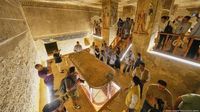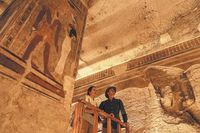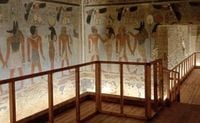The ancient sands of Luxor have once again yielded a treasure for the world: the tomb of Pharaoh Amenhotep III, one of Egypt’s greatest rulers, has been officially reopened to the public after more than two decades of painstaking restoration. The unveiling, which took place on October 4, 2025, marks not only a triumph for Egypt’s heritage but a significant moment for global archaeology and tourism.
According to Egypt’s Ministry of Tourism and Antiquities, the tomb—one of the largest in the Valley of the Kings and Queens—has stood for more than 3,000 years, bearing witness to the grandeur and complexity of the Eighteenth Dynasty. Carved deep into the hillside on the Nile’s west bank, opposite the city of Luxor, the site was first documented in 1799 during the brief Napoleonic conquest of Egypt. Since then, it has endured a long history of excavation, looting, and deterioration, with much of its original contents scattered across prestigious museums worldwide.
The restoration of Amenhotep III’s tomb began in 2004 and unfolded in three major phases, a collaboration between the Egyptian government, the Japanese government, and UNESCO. As reported by Scene Now and confirmed by Waseda University in Japan, the project aimed to save the magnificent wall paintings and reinforce the tomb’s fragile structure. “Decades of deterioration had left the structure at risk of collapse,” noted Japan’s UNESCO mission. The efforts included the treatment of damaged wall reliefs and paintings, reinforcement of walls and ceilings, and installation of modern lighting and ventilation systems to shield the artwork from humidity and further decay.
Mohamed Ismail, secretary-general of the Supreme Council of Antiquities, described the tomb as “a very fascinating tomb,” highlighting its unique features. The burial site boasts a rare ritual depiction of the king’s journey through the afterlife, colossal statues, and vividly colored scenes that remain among the finest examples of ancient Egyptian art. The tomb’s decorative program is especially revered, with paintings portraying Amenhotep III alongside ancient Egyptian deities and scenes drawn from the Book of the Day, the Book of the Night, and the Book of the Dead—a collection of spells designed to guide the deceased through the underworld.
The tomb itself is an architectural wonder, starting with a 36-meter (118-foot) long, 14-meter (45-foot) deep, downward-sloping passageway. This leads to a main burial chamber for the king and two additional chambers for his wives, Queens Tiye and Sitamun. While Queen Tiye, not of royal birth, became Amenhotep’s principal wife and one of the most influential queens in Egyptian history, Sitamun was believed to be their daughter before also becoming his wife. Such marital arrangements were not unusual among pharaohs, serving to consolidate royal bloodlines and reinforce political and religious symbolism.
Amenhotep III, often called Amenhotep the Great, ascended the throne as a teenager and ruled Egypt for nearly four decades, from around 1390 BC to 1350 BC. His reign is remembered for prosperity, stability, and an artistic renaissance. He was also the father of Amenhotep IV, later known as Akhenaten, the pharaoh who famously introduced the short-lived monotheistic worship of Aten, the sun disk deity.
Despite the tomb’s grandeur, its treasures have been dispersed far and wide. Following French and British excavations in 1799 and 1915, most of the tomb’s contents—including the sarcophagus—were removed and now reside in institutions such as the Louvre Museum in Paris, the Metropolitan Museum of Art in New York, and Highclere Castle in the United Kingdom. Amenhotep III’s mummy, meanwhile, was relocated by ancient priests to the tomb of his grandfather, Amenhotep II, also in the Valley of the Kings. Today, the damaged mummy is displayed alongside 16 other royal mummies at Cairo’s National Museum of Egyptian Civilization. His sarcophagus is also housed there, while colossal statues of the pharaoh and his wife can be found in the Egyptian Museum in Tahrir and the new Grand Egyptian Museum, both in Cairo.
Nearby, the mortuary temple of Kom al-Hetan—once a testament to Amenhotep III’s architectural ambitions—has suffered extensive damage from centuries of Nile flooding. Yet the two giant granite statues known as the Colossi of Memnon still stand sentinel at the entrance to the ancient valley, greeting visitors as they arrive to explore Egypt’s storied past.
The reopening of Amenhotep III’s tomb comes at a pivotal moment for Egypt’s tourism industry. The event occurred less than a month before the much-anticipated inauguration of the Grand Egyptian Museum near the Giza Pyramids, slated for November 1, 2025. This strategic timing is no accident. As noted by the Associated Press and other outlets, Egypt’s tourism sector has struggled in the wake of the political turmoil and violence that followed the 2011 uprising, which ended President Hosni Mubarak’s three-decade rule. Reviving interest in the nation’s rich pharaonic heritage is seen as essential to attracting foreign visitors and bolstering a critical source of foreign currency.
The restoration project, led by Japanese experts and supported by UNESCO, is emblematic of the international cooperation required to preserve humanity’s shared heritage. The detailed work included not just artistic conservation but also engineering, environmental control, and the introduction of visitor-friendly infrastructure. The result is a site that can be safely enjoyed by the public while ensuring the protection of its irreplaceable treasures for generations to come.
For visitors, the experience is nothing short of breathtaking. The tomb’s wall paintings, some of the most exquisite surviving from the Eighteenth Dynasty, shimmer with the same vivid colors that greeted ancient priests and mourners over three millennia ago. The scenes of Amenhotep III’s journey through the afterlife, flanked by gods and goddesses, offer a window into the beliefs, artistry, and ambitions of one of history’s greatest civilizations.
As Egypt looks to the future, the reopening of Amenhotep III’s tomb stands as a powerful reminder of the enduring allure of its ancient wonders. The careful balance of preservation, public access, and international collaboration showcased in this project may well serve as a model for heritage sites around the world facing the twin challenges of time and tourism.
With the doors of Amenhotep III’s tomb once again open, a new generation of explorers and dreamers can step into the shadows of the past, marvel at the achievements of a remarkable pharaoh, and carry the story of ancient Egypt into the future.


